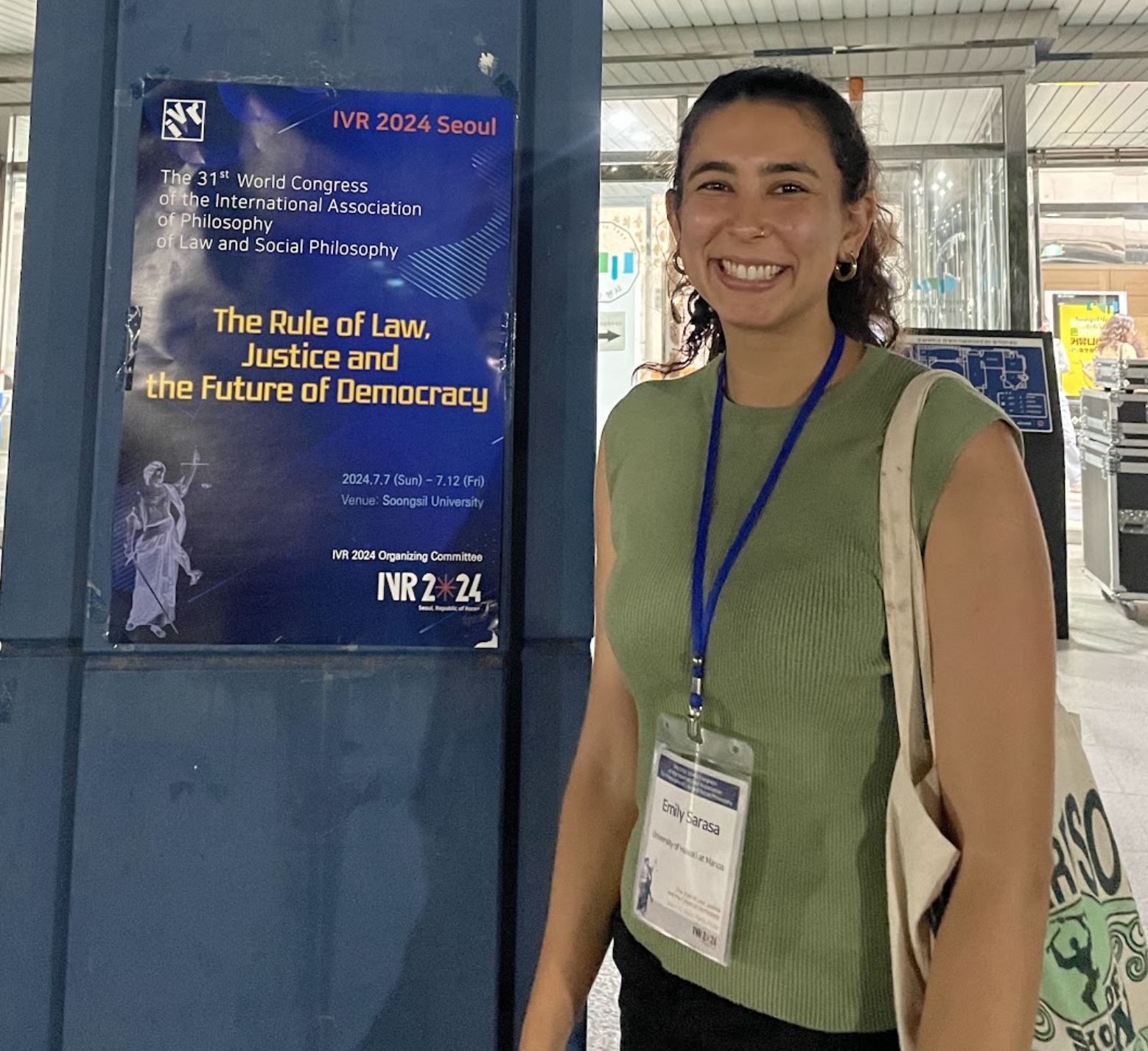
Background
This summer, Emily Sarasa, a 2024 graduate from the William S. Richardson School of Law and an Environmental Law certificate recipient, wrote this blog post for ELP about her experience at the 31st World Congress of the International Association for Philosophy of Law and Social Philosophy in Seoul, South Korea.
Introduction
I attended the 31st World Congress of the International Association for Philosophy of Law and Social Philosophy in Seoul, South Korea. I presented my research on environmental defender protest rights at the United Nations Framework Convention on Climate Change Conference of the Parties (UNFCCC COP) at a workshop titled “Theorizing Protest and Legal Mobilization.”
Student Research and Conference Travel Opportunities
I wanted my Fall International Protection of Human Rights (IPHR) course paper to reflect my experiences attending COP27 and COP28. COP stands for Conference of the Parties, which is the annual meeting of countries that are signatories to the United Nations Framework Convention on Climate Change (UNFCCC). I chose to research freedom of assembly at the COP because of my concern with limitations on the participation of civil society in global climate negotiations. Coincidentally, a Student Bar Association newsletter at the end of the semester included an international conference workshop call for abstracts on protest rights. I submitted the abstract, which was basically my IPHR paper introduction without the recommendations.
Once the workshop organizers accepted my paper, I enrolled in one credit of directed study the next semester with Professor Forman to continue the research. In the semester leading up to the conference, I worked through two rounds of edits on the paper and conducted additional interviews with environmental defenders, a United Nations Special Rapporteur, and researchers from international human rights non-governmental organizations. I used my airline miles to cover the flight to the conference and successfully applied for an Environmental Law Program travel grant, which funded my dorm room stay, ground transportation, and the conference registration fee.
The conference itself was a weeklong ordeal full of diverse workshop topics and plenary sessions. I felt proud to present my research and enjoyed getting feedback from the other workshop participants. My favorite presentations were ones that touched on topics from my International Environmental Law and IPHR courses, like On the Value of Nature and On the Right to the City.
My workshop group plans to publish our papers together in Winter 2024. It was wonderful to talk story with people from all over the world, including my dormitory roommate, a Vietnamese political science PhD candidate studying in Austria. We stayed up in the evenings exchanging what we learned from the workshops and plenaries, discussing legal philosophy, and sharing about our lives! Attending this conference was a highlight of my law school experience.
Dr. Julie Saada’s Presentation
I was most excited to attend Dr. Julie Saada’s plenary because of my familiarity with her work through courses and moot court research. Her presentation, the “Three Dialectics of Human Rights,” stressed the interdependence of civil-political and socio-economic rights. I have spent the months since this presentation thinking about its relation to human rights in Hawaiʻi.
Rights under the International Covenant on Civil and Political Rights (ICCPR) and International Covenant on Economic, Social and Cultural Rights (ICESCR) are often presented as independent, and sometimes even distinguished as Western vs. Eastern or Global North v. South value systems. But civil-political and socio-economic rights facilitate the exercise and protection of each other. I see Saada’s theory about the interdependence of these rights most clearly in my current work in Hawaiʻi with unsheltered and justice-impacted people, who are disproportionately Native Hawaiian. These individuals struggle to shape the political systems that could lift them out of poverty and cyclical overcriminalization. Discrimination, poverty, and underinvestment in education keep them disenfranchised and trapped.
Particularly in Hawaiʻi, environmental human rights should be viewed through Saada’s intersectional lens. Communities that enjoy their exercise of civil-political and socio-economic rights are in the best position to advocate for their environmental right to a clean and healthy environment. Native Hawaiian cultural rights and environmental rights are likewise inextricably linked and mutually reinforcing.
Reflecting on the movement against the Thirty Meter Telescope on Mauna Kea and resulting protests and arrests, Saada’s intersectional approach seems relevant to the ongoing 2029 military lease renewal issue in Hawaiʻi. Despite the community’s overwhelming advocacy against the military’s lease renewals before the Board of Land and Natural Resources and in the Environmental Impact Statement process, the state of Hawaiʻi seems poised to renew the leases. Communities and organizations concerned with our human rights, whether civil, political, economic, cultural, social, or environmental, should coalesce around the issue because they all have an interest in ensuring the best possible outcome.
Other Travel Highlights
I decided to visit Seoul for an extra week before the conference to see a friend and explore the city. I enjoyed Seoul’s thoughtful urban design, climate-conscious greenscaping, and efficient public transit. I loved learning about Korean history, including Japan’s occupation in the 20th century. The city is gorgeous, with greenery integrated into the urban area and the most functional public transit system I have ever experienced.
I also took a one-day trip to Jeju Island, a UNESCO World Heritage Site.
Hiking Cheongsu Gotjawal Forest (Gotjawal was designated as a UNESCO Biosphere Reserve in 2002)
Seaseom Bridge – Saeyeongyo Bridge
Finally, I toured the Korean Demilitarized Zone, the land dividing North and South Korea. Other than the many military outposts, stations, and turrets, the land is beautifully lush and maintained by traditional farmers. It felt odd eating fresh blueberries and ice cream from the soybeans grown in such militarized lands.
Food produced in the DMZ
The Korean Demilitarized Zone (DMZ), the buffer zone between North and South Korea, is a lush farmland accented with military outposts.
The South Korean government subsidizes traditional farmers, who grow crops like blueberries and soybeans that I purchased at outposts in the area. Wildlife thrives at the border.
A Comfort Women memorial statue in the DMZ.
K.G. 03/05/2025
